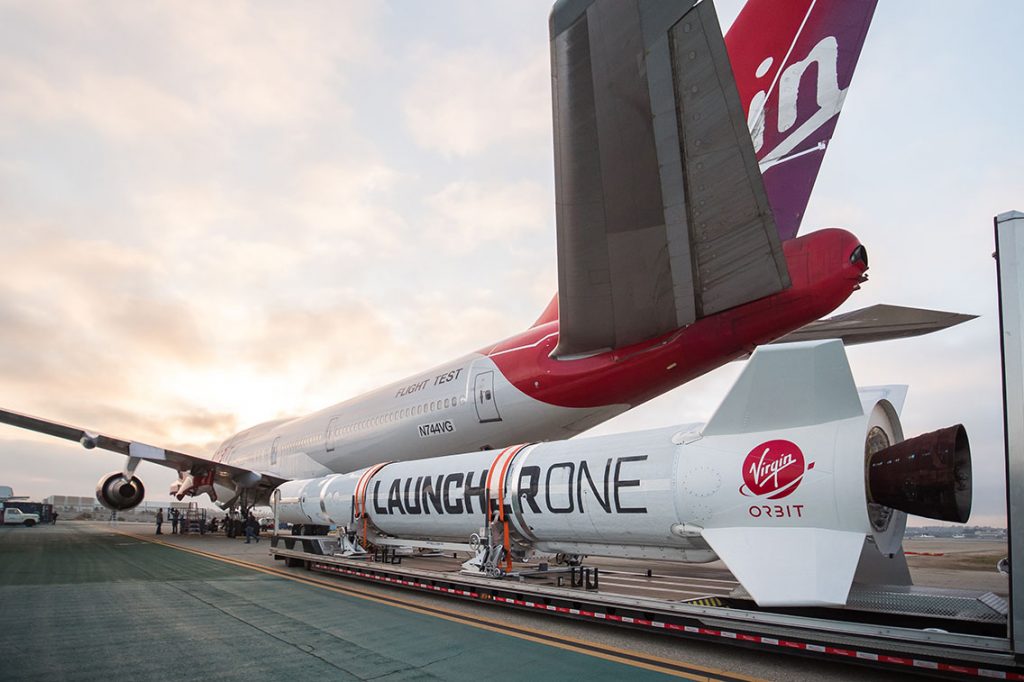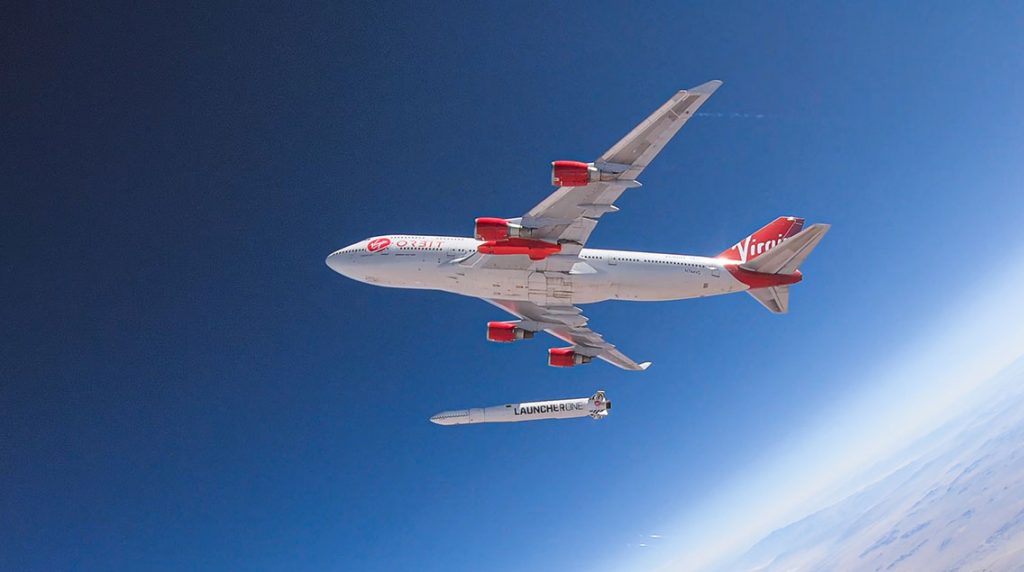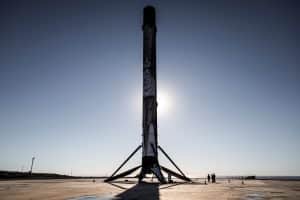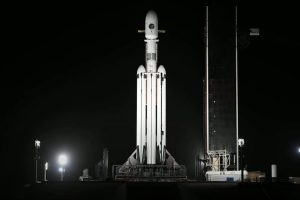SpaceX’s reign as the only privately funded American spaceflight company to reach and successfully deploy small satellite payloads into orbit ended on January 21, 2018, when Rocket Lab’s Electron rocket delivered three customer CubeSats to orbit for the first time.
SpaceX and Rocket Lab have since been the only private American companies to offer dedicated and rideshare delivery of small satellites to orbit. That is until Virgin Orbit joined the competition with the success of its Launch Demo 2 mission earlier this week.
AIRDROPPING ROCKETS
On Sunday, January 17, Virgin Orbit – one of two spaceflight companies backed by billionaire Richard Branson – joined SpaceX and Rocket Lab as the next private American rocket launcher sending small satellites to space. Virgin Orbit delivers its payload slightly differently than SpaceX and Rocket Lab. Virgin Orbit can uniquely offer its customers the flexibility of launch site because its liquid-fueled rocket is dropped mid-air from under the wing of a massive Boeing 747 before propelling itself to space.
In the Spring of 2020 Virgin Orbit conducted its first Launch Demo mission off of the coast of southern California. Prior to the rocket’s first stage ignition, the company achieved the majority of its intended test flight targets. Just after LauncherOne’s first stage ignition the rocket prematurely shut down resulting in the complete loss of the rocket and its payload as it fell to the ocean.

After months of investigation, Virgin Orbit attributed the prematurely terminated flight to a component failure that led to a breach of a high-pressure line starving the engine of Liquid Oxygen resulting in the immediate loss of propulsion. The issue was remedied quickly and Virgin Orbit aimed to fly and launch again in December 2020 for its Launch Demo 2 mission attempting to successfully achieve orbit by the close of the year. In mid-December, the launch date of Launch Demo 2 was postponed until January 2021 due to impacts to operation and scheduling caused by the Covid-19 pandemic.
Virgin Orbit’s 747, Cosmic Girl, piloted by Kelly Latimer took to the skies on Sunday, January 17 with a fully fueled LauncherOne rocket loaded with a payload of nine CubeSat missions made up of ten spacecraft for NASA’s Educational Launch of NanoSatellites (ELaNa XX) series contracted under NASA’s Venture Class Launch Services program.

The Launch Demo 2 mission went off without a hitch. Just as with the first Launch Demo, all pre-launch activities proceeded nominally with Cosmic Girl reaching an altitude of 30,000 feet prior to the release of LauncherOne over the Pacific Ocean. Once released into free flight, the rocket’s first stage engine ignited and carried it through the atmosphere until separation and second stage engine ignition beyond the Kármán line – the recognized point at which “space” is defined beyond Earth’s atmosphere. Eventually, all nine payloads were successfully deployed into orbit completing the first-ever successful mission of an orbital class, liquid-fueled, air-launched rocket to reach space.
ANOTHER ONE LEAVES THE CRUST
SpaceX has set the pace for space in 2021 successfully achieving two orbital-class launches within the first twenty days of the year with a third mission scheduled to depart Launch Complex 40 at Cape Canaveral Space Force Base in Florida on Friday, January 22. Likewise, Rocket Lab looks to aggressively exceed its previous launch record of seven missions in one calendar year. The only way to demolish a previous record is to launch frequently from multiple spaceports. SpaceX currently has three active launchpads, two in Florida and one in California. Within 2021, Rocket Lab will also have three operational launchpads, two in New Zealand and one in Virginia.
On Wednesday, January 20, 2021 – its third anniversary of first making it to orbit – Rocket Lab successfully launched its first Electron mission of 2021 nicknamed “Another One Leaves The Crust.” After standing down from a previous launch attempt on January 16 due to an erroneous sensor, the eighteenth overall mission of the Electron rocket successfully launched and deployed a single communications microsatellite for the European space technology company, OHB Group. The mission took place from Launch Complex 1 in Mahia, New Zealand at 07:26 UTC. This mission brings the total satellites deployed by Rocket Lab to 97.
In a statement provided by Rocket Lab, founder and CEO, Peter Beck, states that “We’re proud to be delivering a speedy and streamlined path to orbit for OHB Group on this mission, with launch taking place within six months of contract signing. By flying as a dedicated mission on Electron, OHB and their mission partners have control over launch timing, orbit, integration schedule, and other mission parameters.”
2021 – THE YEAR OF THE SMALL SATELLITE LAUNCHER
Expect SpaceX, Rocket Lab, and Virgin Orbit to be joined by other small launchers looking to break into the market sooner rather than later. Another NASA Venture Class Launch Services provider, Astra – a California-based small satellite launcher that launches from Kodiak, Alaska – narrowly missed beating out Virgin Orbit for the third-place slot in the competition to deliver small satellites to orbit.
On December 15, 2020, Astra launched its small orbital-class vehicle, Rocket 3.2, for the second time from Pacific Spaceport Complex on Kodiak Island, Alaska. The vehicle soared past the Kármán line with the upper stage reaching its targeted altitude of 380 kilometers at 7.2 km/sec but falling just shy of achieving orbital velocity at 7.68 km/sec.
Astra is not the only small private spaceflight company looking to join the ranks of SpaceX, Rocket Lab, and now Virgin Orbit. Texas-based Firefly Aerospace is also expected to join the elite group of privately funded spacefaring companies this year.
In October 2020, Firefly successfully completed acceptance testing of the first stage of its small class Alpha rocket. The stage completed a 35-second static fire demonstrating a full range of thrust vector control maneuvers. The first stage of the Alpha rocket has since been shipped to Firefly’s launch complex at Space Launch Complex 2 West (SLC-2W) at Vandenberg Air Force Base in California. In Novemeber 2020 Firelfy began the integration process of the payloads for the maiden Alpha launch.
In December 2020, Astra and Firefly were awarded Venture Class Launch Services Demonstration 2 firm fixed-priced contracts by NASA’s Launch Services Program along with a third small class launcher, California based Relativity Space. Astra received $3.9 million in funding while Firefly was awarded $9.8 million and Relativity received $3 million to place CubeSats in Low Earth Orbit.
SmallSats and CubeSats are quickly becoming the preferred method of operating in orbit because it is technology and opportunity that is attainable for many smaller companies and other parties interested in reaching space such as universities. As SmallSats continue to rise in popularity so too will the demand to launch them. 2021 is already shaping up to become the year that produces the highest amount of private commercialized spaceflight, ever.
Original Publication by Jamie Groh at Teslarati.





